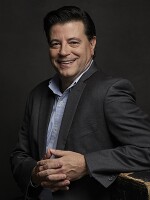Japanese photographer Komatsu Hiroko’s work is big.
So big, that to develop film on this scale, photography students at the University of Hartford recently had to bring in a horse trough to submerge the photographic paper.
“Because she was saying the roll of paper should usually float in the fixer, and there wasn’t enough,” said Nicholas DeLeo, a photography student at UHart.
Carrie Cushman, director and curator of UHart’s Joseloff Gallery, said students started working at 9 a.m. that day. “It’s 3 o’clock now. We’re close to being able to wash the photographs, so I think we have another two hours ahead of us to get it all set up to dry.”

The final product is 18 black-and-white photographs, developed on a single, 50-foot roll of photographic paper.
The photographs reflect Komatsu’s obsession with materials from either construction or demolition sites in Tokyo and are part of an exhibit she has running at UHart through Dec. 10.

Komatsu lives in Tokyo, a metropolis that is in a constant flux of urban development. Industrial sites are ubiquitous there, and Komatsu is fascinated with the materials that are either recovered from a demolition site or are part of new construction.
“I see the materials used in the industrial district — it’s very hard to tell what it is used for, or what it will become,” Komatsu said through an interpreter. “It is also very hard to tell whether it’s in the process of making something, or it’s in the process of demolishing something.”

Another trademark of Komatsu’s work is its scale.
She covers almost the entire exhibition space with the rolls of photographs — not just the walls, but on the floor, and draping over wire hangers as well.
Cushman said the effect can be overwhelming.
“It’s a full body experience,” Cushman said. “Typically, when you go to a photography exhibit, you see individual photographs in frames hanging on the walls. It’s impossible to focus on the images in her show. You’re trying to look, and the environment keeps pulling your body back to the totality of it. And it’s even more than a visual effect. You are still going to be able to smell the chemistry from the photographs when they are up in the gallery.”

Komatsu Hiroko agrees that people are often taken aback when they enter one of her exhibits.
“They’re surprised, including me,” Komatsu said. “Initially it was thought that it’s impossible to make art that is this big. Usually shock is their first reaction. My intention is to make you have a sense that you are losing gravity.”
DeLeo, the photography student, said his experience helping Komatsu develop her large photographs has changed the way he thinks about his own art.
“Seeing it so big, it’s really changed my perspective on what I want to take pictures of, and what size I am enlarging them and how that is going to change the perspective on the viewer,” he said.

And changing the viewer’s frame of reference is really at the core of Komatsu’s monochromatic, sensory-overload installations.
“The reason why I started such a large project is because I thought if we extend — surpass a certain threshold — you may see the world from a different perspective,” she said.
“Komatsu Hiroko: Second Decade” runs at the University of Hartford’s Joseloff Gallery through Saturday, Dec. 10.





